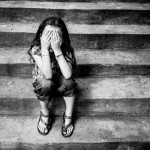
Childhood maltreatment involves the potential or actual harm to a child, resulting from an act or failure to act, whether intentional or not. It encompasses emotional, physical and sexual abuse, neglect, and the witnessing of domestic violence. Research evidences an association between childhood maltreatment and poor psychological health in adult life; rates are particularly high in individuals suffering from severe mental disorders (typically disorders involving psychosis) (Sugaya et al, 2012).
Childhood maltreatment is highly prevalent among individuals with bipolar disorder; rates in the region of 40-50% are typically reported (Post et al, 2013; Leverich et al, 2002; Garno et al, 2005). Research suggests that, in adults with mental health conditions, having a history of childhood maltreatment may negatively affect the clinical course of the disorder (Post et al, 2013; Sala et al, 2014). Biological alterations have been linked to childhood maltreatment, and are postulated as one mechanism by which bipolar disorder progression could be affected. Systems implicated include inflammatory and stress response systems, and neuroplasticity mechanisms.
Bipolar research has consistently indicated that maltreatment may be associated with a range of negative clinical outcomes, including: adverse illness progression, younger age of onset, impaired cognitive function, increased risk for suicide attempts, increased number of depressive episodes, increased mania severity, increased comorbidity (including post-traumatic stress disorder (PTSD), panic disorder and substance use disorders), increased risk for psychosis, rapid cycling, and higher likelihood for suicide attempt. An earlier review (Daruy-Filho et al, 2011) highlighted the need for caution in interpretation of such studies due to limitations of study designs, small sample sizes, and variability of childhood trauma definitions.
This systematic review and meta-analysis set out to examine whether a history of childhood maltreatment in individuals with bipolar disorder was associated with an increased risk for negative clinical outcomes. Heterogeneity of findings across the literature was also explored.

Childhood adversities consistent with maltreatment are highly prevalent in patients diagnosed as adults with bipolar disorder.
Methods
The research was conducted in accordance with PRISMA and MOOSE guidelines for reporting systematic reviews and meta-analyses. Databases MEDLINE, PSYCHINFO and Embase were searched using key terms pertaining to child maltreatment and bipolar disorder. Thirty studies were deemed eligible and included in the meta-analysis.
Studies were included if:
- Published in English, prior to January 1, 2015
- Maltreatment occurred before 18 years of age
- Adversities examined were consistent with maltreatment (physical abuse, sexual abuse, emotional abuse, neglect, or family conflict)
- Data was available for 12 outcome measures of clinical features and illness course.
Outcome measures
Clinical course of illness in individuals with bipolar disorder, as evidenced by:
- Mania, depression, and psychosis severity
- Comorbidity: PTSD, anxiety disorders, substance misuse disorders, and alcohol misuse disorder
- Age of onset
- Rapid cycling
- Number of manic and depressive episodes
- Risk of suicide attempt
Analysis
- Data extraction was completed independently and included mean age of sample, sex distribution, prevalence of bipolar disorder type 1 in sample, maltreatment measure and definition, bipolar disorder outcome measures, and study quality
- Data was converted to odds ratio (OR) effect sizes. An OR greater than 1 indicates an increased likelihood of unfavourable clinical features in individuals with bipolar disorder who have a history of childhood maltreatment
- Heterogeneity (variation of effects) between studies was tested. Five of the meta-analyses had significant heterogeneity
- Publication bias was assessed both visually and statistically. Results were not deemed to have been biased by selective publication
- Quality of epidemiological studies was assessed. Ratings ranged from 6 to 10; studies examining mania severity were of the lowest quality, whereas age of bipolar disorder onset was the highest.
Results
- Independent meta-analyses were conducted for each of the 12 target measures
- The meta-analyses included a median of 8 studies (range 6-14) and 3,666 participants (range 780 to 5,733).
Across all meta-analyses, individuals with bipolar disorder who had a history of childhood maltreatment had unfavourable clinical outcomes and illness course compared to those with bipolar disorder who did not experience childhood maltreatment (median effect size OR = 1.85).
All 12 outcome measures were significantly related to childhood maltreatment. The largest effect sizes were found for risk of suicide attempt and comorbidity with post-traumatic stress disorder. Individuals with bipolar disorder who had a history of childhood maltreatment were over twice as likely to attempt suicide, and over three and a half times more likely to have comorbid PTSD, than individuals with bipolar disorder without such a history.
Additionally, individuals with bipolar disorder and a history of childhood maltreatment had a greater risk of mania, depression and psychosis symptoms severity, higher risk of comorbidity with anxiety disorders, substance misuse disorders, and alcohol misuse disorder, an earlier age of bipolar disorder onset, higher risk of rapid cycling, and greater numbers of manic and depressive episodes.

This systematic review shows that childhood maltreatment is associated with an unfavourable course of bipolar disorder in adult years.
Conclusions
In a population in which childhood maltreatment is highly prevalent, this research lends support to the notion that such maltreatment is associated with unfavourable clinical outcomes and illness course.
However, the authors emphasise the need for interpreting these findings within the context of certain limitations. Particular uncertainty lies in whether childhood maltreatment is put forward as a causal risk factor for bipolar disorder, or as an exposure that is associated with bipolar but is not its cause.
Strengths and limitations
The study accounts for publication bias, undue effects of individual studies, and variations in study quality. Results provide evidence that quantitatively summarises the associations between childhood maltreatment and illness course, and has important implications for understanding bipolar disorder progression and underlying mechanisms.
- It is unclear whether childhood maltreatment is a causal risk factor for bipolar disorder or whether it is merely associated with bipolar disorder and not its cause. Maltreatment may contribute additively to more extensive psychopathology seen in adulthood.
- The retrospective self-report nature of childhood maltreatment assessments used by many studies presents several issues, including: difficulties recalling information; “effort after meaning”, whereby one looks for a justification of disorder-related changes; falsely recovered memories; intentional non-disclosure; and possibly infantile amnesia (early abuse not recalled due to retention of fewer memories at an early age). The latter two in particular, however, would only serve to further reinforce significant results.
- Childhood maltreatment recall may have been affected by the level of psychopathology at time of report; depressive mood-state is postulated to increase the probability of negative-event recall, and vice versa for elated mood-states. Failure to assess participants in a euthymic state may lead to inaccurate rates, although evidence on this subject is mixed.
- Confounders, such as genetics, may have had an impact on the results of the study, though authors cite evidence of an association of maltreatment with bipolar disorder when all individuals had familial risk for bipolar disorder.
- Studies included did not examine pre-existing psychopathology; i.e. does childhood maltreatment increase risk for bipolar disorder or does the presence of psychopathology in childhood increase the risk for maltreatment and later poorer outcomes? Evidences suggests that some individuals with bipolar disorder do experience mild but discernible symptoms during childhood (Correll et al, 2007).
- There was significant variability between studies in 5 of the meta-analyses. Variability was not explained by study quality, and a random-effects model accounted for part of the across-study variability. Explaining heterogeneity is important, and results of meta-analyses (mania severity, PTSD, anxiety disorder, and substance misuse disorder comorbidity, and age of bipolar disorder onset) should be cautiously considered.
- Additionally, omission of certain studies led to meta-analyses with non-significant estimates. In the psychosis severity analysis, elimination of one study, and, in the depressive episodes analysis, elimination of two studies, resulted in non-significant associations with childhood maltreatment: i.e. the effect of association seen was highly driven by these studies.
- Further research could explore understanding the influence of specific forms of maltreatment on bipolar disorder outcomes; for example, sexual abuse may be the strongest predictor of rapid cycling.
Summary
Clinical implications:
- A history of childhood maltreatment could be an early indicator of disorder progression, helping identify individuals who might be at risk of a more undesirable disorder course.
- Potential to stratify patients according to their risk for certain undesirable outcomes means treatment could be more targeted and specific.
- Results lead the authors to suggest that the use of established treatment processes, such as those used in major depression, may be appropriate, including pharmacological interventions that target biological vulnerabilities. Additionally, comorbidities with PTSD and anxiety disorders lead to implications of trauma and anxiety-based treatments to improve illness course.
- Clinicians may consider checking for childhood trauma in patients with bipolar disorder or in those with a more severe or unremitting course.

These findings emphasise the importance of collaboration between child and adolescent and adult psychiatry as a key to early monitoring and treatment of conditions like bipolar disorder.
Future research
The authors conclude:
If causal, findings from our study lend support to the notion that childhood maltreatment can affect neurobiological processes associated with bipolar disorder progression, which is consistent with the stress-sensitisation model.
Future research should increase understanding of the underlying mechanisms (i.e. how maltreatment affects neurobiological processes) and facilitate the application of such knowledge when developing treatment strategies. Research to test whether a history of maltreatment can predict treatment response is also important. The specific role of each maltreatment subtype, however, remains a subject of debate and future research may also consider exploring this.

Childhood adversity might well be a general risk factor for adult morbidity, not just for mental illness, but also for diabetes, cardiovascular disease or other chronic conditions.
Links
Primary paper
Agnew-Blais J, Danese A. (2016) Childhood maltreatment and unfavourable clinical outcomes in bipolar disorder: a systematic review and meta-analysis. The Lancet Psychiatry, 3, 342-49. dx.doi.org/10.1016/S2215-0366(15)00544-1
Other references
Sugaya L, Hasin DS, Olfson M, Lin KH, Grant BF, Blanco C. (2012) Child physical abuse and adult mental health: a national study. Journal of Traumatic Stress, 25(4), 384-92.
Post RM, Altshuler L, Leverich G, Nolen W, Kupka R, Grunze H, … Rowe M. (2013) More stressors prior to and during the course of bipolar illness in patients from the United States compared with the Netherlands and Germany. Psychiatry Research, 210(3), 880-86.
Leverich GS, McElroy SL, Suppes T, Keck PE Jr, Denicoff KD, Nolen WA, … Post RM. (2002) Early physical and sexual abuse associated with an adverse course of bipolar illness. Biological Psychiatry, 51, 288-297.
Garno JL, Goldberg JF, Ramirez PM, Ritzler BA. (2005) Impact of childhood abuse on the clinical course of bipolar disorder. The British Journal of Psychiatry, 186(2), 121-125.
Sala R, Goldstein BI, Wang S, Blanco C. (2014) Childhood maltreatment and the course of bipolar disorders among adults: epidemiological evidence of dose-response effects. Journal of Affective Disorders, 165, 74-80.
Daruy-Filho L, Brietzke E, Lafer B, Grassi-Oliveira R. (2011) Childhood maltreatment and clinical outcomes of bipolar disorder. Acta Psychiatrica Scandinavica, 124(6), 427–34.
Correll CU, Penzner JB, Lencz T, Auther A, Smith CW, Malhotra AK, Kane JM, Cornblatt BA. (2007) Early identification and high-risk strategies for bipolar disorder. Bipolar Disorders, 9(4), 324-38.

Childhood maltreatment and bipolar disorder https://t.co/NG5HT66Obl #MentalHealth https://t.co/FFplEVbK54
Childhood maltreatment and bipolar disorder https://t.co/TNoVFS3NQJ #mentalhealth
Childhood maltreatment and bipolar disorder https://t.co/sBlEDQf3Rb One of our MSc students @emilycurrell blogging for @Mental_Elf
Meta-analysis on childhood maltreatment & bipolar disorder from @agnew_blais, @stressdev summarised by @Mental_Elf https://t.co/pK5Fc2rjuc
Childhood adversity is highly prevalent in patients diagnosed as adults with bipolar disorder https://t.co/aYuo71jilF
RT @expertlinkorg: Childhood maltreatment and bipolar disorder https://t.co/aRMQ5ZwL10
Recent @TheLancetPsych SR shows that childhood maltreatment is assoc w unfavourable course of bipolar disorder https://t.co/aYuo71jilF
Childhood maltreatment & unfavourable clinical outcomes in bipolar disorder: we report on recent SR/MA https://t.co/aYuo71jilF
RT @Mental_Elf: Research emphasises importance of collaboration btwn child & adult psychiatry as key to early monitoring & treatment https:…
@JamieLarsH @RichardBentall @Mental_Elf @emilycurrell https://t.co/tCeRsSELEY
Don’t miss: Childhood maltreatment and bipolar disorder https://t.co/aYuo71jilF #EBP
RT @cgblanch1: El maltrato en la infancia es altamente prevalente en adultos con trastorno bipolar, y tiene peor curso https://t.co/y0TvoZ6…
Childhood maltreatment and bipolar disorder https://t.co/CwmYd9Cv10 via @sharethis
Childhood maltreatment and bipolar disorder https://t.co/0jdX5Ow9Ea
Childhood maltreatment and bipolar disorder https://t.co/QAb4VRYzTy via @sharethis
Childhood maltreatment and bipolar disorder https://t.co/3HKtoZhxlf
RT @cheerfulbabies: Childhood maltreatment and bipolar disorder – https://t.co/2Dr9KLl8pm
Is there a conenction? #childabuse and Bi-polar https://t.co/6hQ70wQu3E #fostercare
Childhood maltreatment and bipolar disorder https://t.co/tfvGc4MSrr
[…] childhood maltreatment are diagnosed with severe mental disorders in adulthood. An article by National Elf Service, discusses research that shows a link in bipolar disorder in children and childhood […]